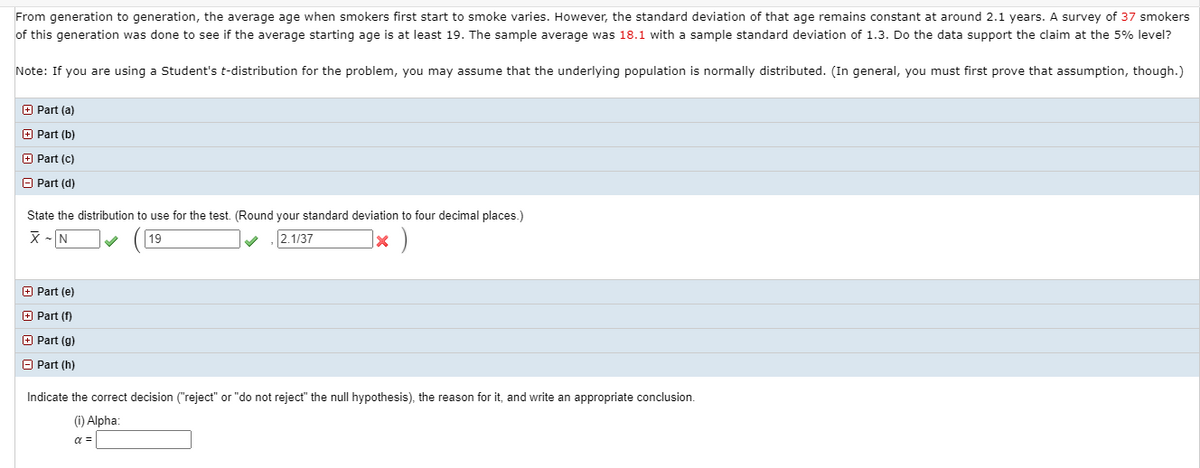From generation to generation, the average age when smokers first start to smoke varies. However, the standard deviation of that age remains constant at around 2.1 years. A survey of 37 smokers of this generation was done to see if the average starting age is at least 19. The sample average was 18.1 with a sample standard deviation of 1.3. Do the data support the claim at the 5% level? Note: If you are using a Student's t-distribution for the problem, you may assume that the underlying population is normally distributed. (In general, you must first prove that assumption, though.) O Part (a) O Part (b) O Part (c) O Part (d) State the distribution to use for the test. (Round your standard deviation to four decimal places.) X- N 19 2.1/37 O Part (e) O Part (f) O Part (g) O Part (h) Indicate the correct decision ("reject" or "do not reject" the null hypothesis), the reason for it, and write an appropriate conclusion. (i) Alpha: a =
From generation to generation, the average age when smokers first start to smoke varies. However, the standard deviation of that age remains constant at around 2.1 years. A survey of 37 smokers of this generation was done to see if the average starting age is at least 19. The sample average was 18.1 with a sample standard deviation of 1.3. Do the data support the claim at the 5% level? Note: If you are using a Student's t-distribution for the problem, you may assume that the underlying population is normally distributed. (In general, you must first prove that assumption, though.) O Part (a) O Part (b) O Part (c) O Part (d) State the distribution to use for the test. (Round your standard deviation to four decimal places.) X- N 19 2.1/37 O Part (e) O Part (f) O Part (g) O Part (h) Indicate the correct decision ("reject" or "do not reject" the null hypothesis), the reason for it, and write an appropriate conclusion. (i) Alpha: a =
Glencoe Algebra 1, Student Edition, 9780079039897, 0079039898, 2018
18th Edition
ISBN:9780079039897
Author:Carter
Publisher:Carter
Chapter10: Statistics
Section10.3: Measures Of Spread
Problem 26PFA
Related questions
Question

Transcribed Image Text:From generation to generation, the average age when smokers first start to smoke varies. However, the standard deviation of that age remains constant at around 2.1 years. A survey of 37 smokers
of this generation was done to see if the average starting age is at least 19. The sample average was 18.1 with a sample standard deviation of 1.3. Do the data support the claim at the 5% level?
Note: If you are using a Student's t-distribution for the problem, you may assume that the underlying population is normally distributed. (In general, you must first prove that assumption, though.)
+ Part (a)
+ Part (b)
+ Part (c)
A Part (d)
State the distribution to use for the test. (Round your standard deviation to four decimal places.)
X - N
19
2.1/37
E Part (e)
O Part (f)
O Part (g)
O Part (h)
Indicate the correct decision ("reject" or "do not reject" the null hypothesis), the reason for it, and write an appropriate conclusion.
(1) Alpha:
a =
Expert Solution
This question has been solved!
Explore an expertly crafted, step-by-step solution for a thorough understanding of key concepts.
Step by step
Solved in 2 steps with 1 images

Knowledge Booster
Learn more about
Need a deep-dive on the concept behind this application? Look no further. Learn more about this topic, statistics and related others by exploring similar questions and additional content below.Recommended textbooks for you

Glencoe Algebra 1, Student Edition, 9780079039897…
Algebra
ISBN:
9780079039897
Author:
Carter
Publisher:
McGraw Hill

Glencoe Algebra 1, Student Edition, 9780079039897…
Algebra
ISBN:
9780079039897
Author:
Carter
Publisher:
McGraw Hill